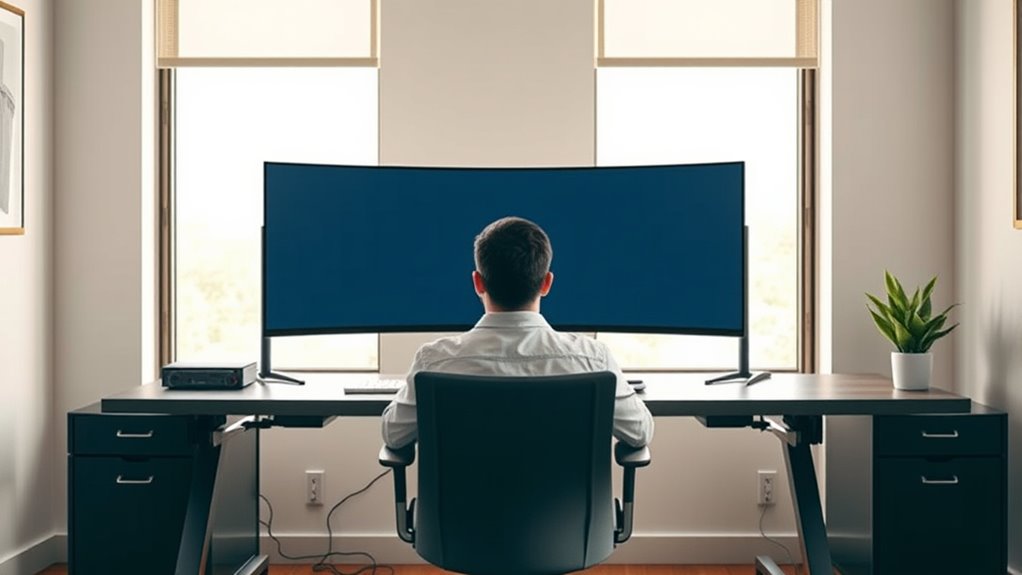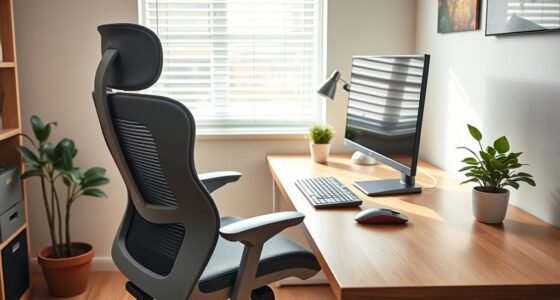To protect your eyes, set your monitor at eye level using risers or adjustable stands, ensuring the top of the screen is at or below your eye line. Keep the screen about an arm’s length away and position it to avoid glare from windows and lighting. Adjust brightness and contrast for comfort, and support a proper ergonomic workspace with supportive chairs and correct desk height. Follow these rules to reduce strain—and there’s more to discover if you continue.
Key Takeaways
- Position your monitor at eye level to prevent neck strain and keep your gaze natural.
- Maintain an arm’s length distance (20-30 inches) from the screen to reduce eye fatigue.
- Adjust your monitor angle to minimize glare from ambient light sources.
- Set appropriate brightness and contrast to match ambient lighting and reduce eye stress.
- Create an ergonomic workspace with supportive chair and proper monitor placement for overall eye health.
Set Your Monitor at Eye Level
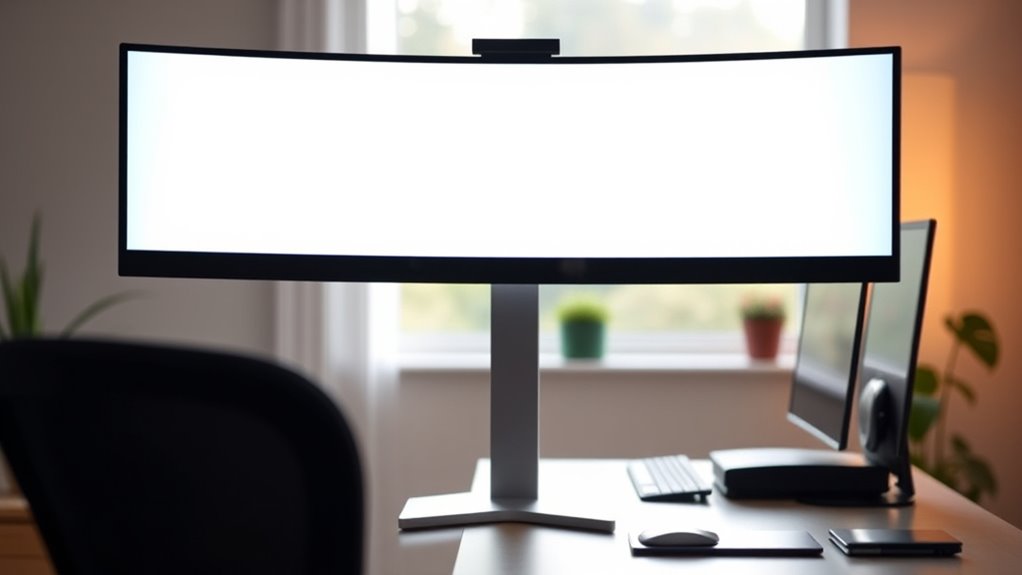
To prevent neck strain and improve your posture, you should set your monitor at eye level. Start by adjusting your desk height so that your monitor sits directly in front of you, with the top of the screen at or just below eye level. An ergonomic chair can help you maintain proper alignment, keeping your feet flat on the floor and your back supported. When your monitor is at the correct height, you won’t have to tilt your head up or down, reducing tension in your neck and shoulders. If needed, use monitor risers or adjustable stands to achieve the ideal position. Proper placement minimizes strain, promotes comfort, and helps you stay productive throughout your workday. Incorporating essential oils for posture relief may also contribute to overall comfort and well-being during long hours of work.
Maintain Proper Viewing Distance
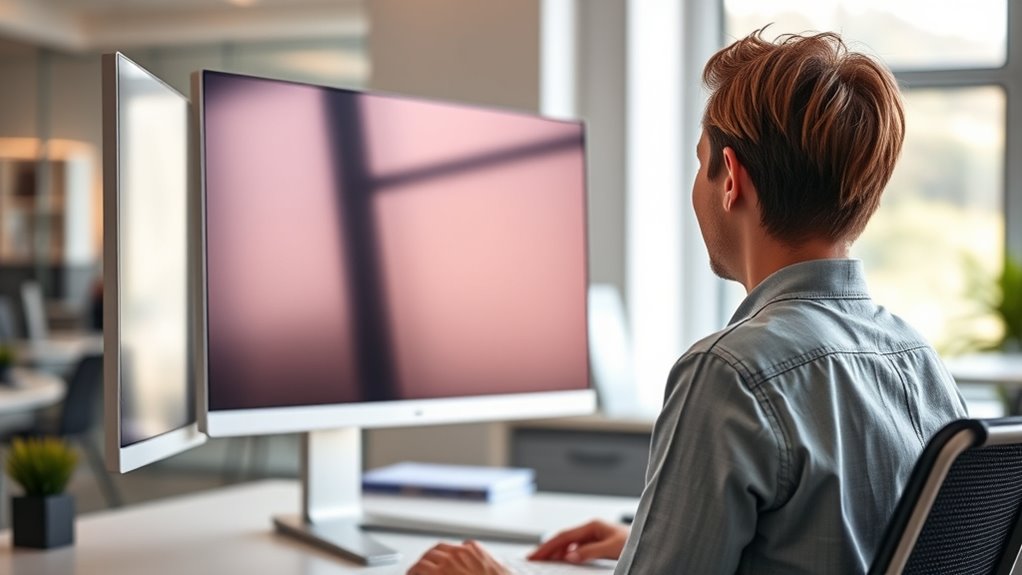
After setting your monitor at eye level, maintaining the proper viewing distance guarantees you don’t strain your eyes or neck. Ideally, sit about an arm’s length away from your screen, roughly 20-30 inches. This distance reduces eye fatigue and helps you view details comfortably. Make certain your ergonomic seating supports good posture, keeping your back straight and feet flat on the floor. Proper keyboard positioning complements monitor placement, preventing you from leaning forward or craning your neck. Adjust your chair and desk height so your arms rest comfortably at a 90-degree angle. By maintaining this distance and aligning your seating and keyboard setup, you minimize strain and promote healthier, more comfortable working conditions. Additionally, staying aware of data privacy concerns related to digital health tools can help protect your personal information while working or gaming.
Position Your Screen to Minimize Glare
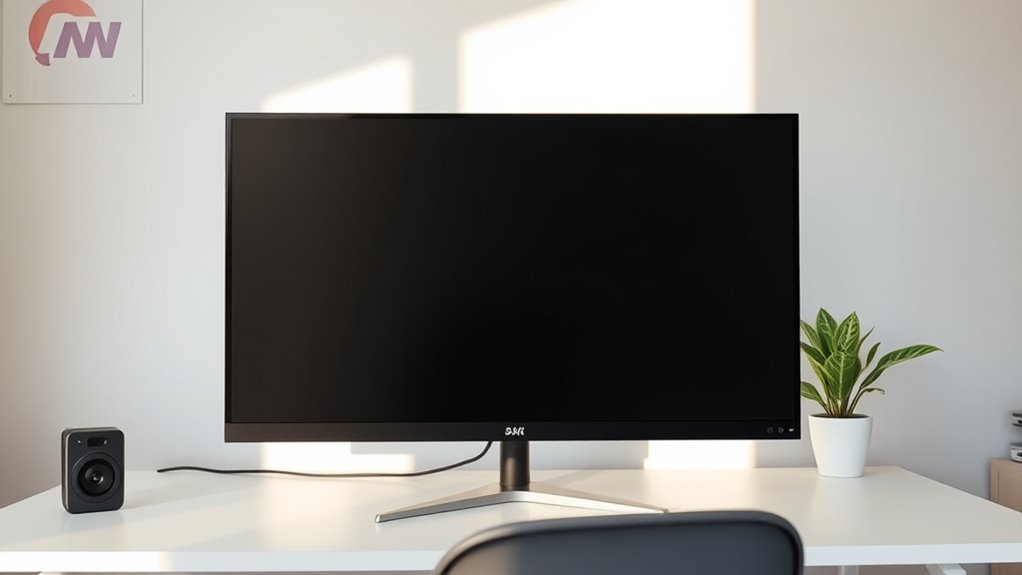
Position your screen so that glare from windows or overhead lights doesn’t reflect directly into your eyes. Screen glare can cause eye strain and make it harder to focus. To reduce glare and improve comfort, consider these tips:
- Adjust your monitor’s angle so that reflections from ambient lighting aren’t visible on the screen.
- Use curtains or blinds to control natural light, preventing harsh sunlight from creating glare.
- Position your workspace away from direct light sources, ensuring ambient lighting doesn’t bounce off your screen.
- Incorporate sound therapy techniques into your routine to further promote relaxation and reduce visual fatigue.
Adjust Brightness and Contrast for Comfort

Adjusting your monitor’s brightness and contrast settings can considerably reduce eye strain and improve overall comfort during long periods of use. Proper brightness levels prevent your eyes from working too hard to see details, while ideal contrast enhances clarity. To reduce blue light exposure, consider enabling blue light reduction features or adjusting color temperature settings to warmer tones. This minimizes eye fatigue caused by intense light. Additionally, set your monitor’s contrast to prevent screen flicker, which can cause eye discomfort and headaches over time. Keep brightness in sync with ambient lighting—neither too bright nor too dim—to avoid unnecessary strain. Regularly adjusting these settings ensures your eyes stay comfortable, especially during extended work sessions or late-night use. Incorporating on-device AI features can help optimize display settings based on your environment and usage patterns, further enhancing eye comfort.
Create an Ergonomic Workspace Environment
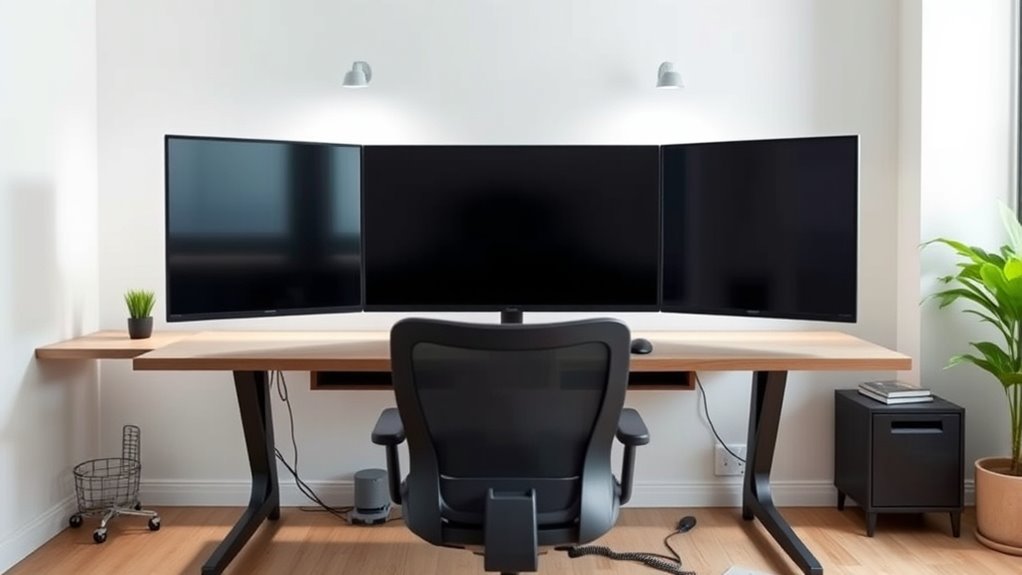
Creating an ergonomic workspace environment involves arranging your desk, chair, and monitor to promote comfort and reduce strain. You should prioritize ergonomic seating that supports good posture and adjusts easily to your body. Proper keyboard positioning is vital—keep it at a height where your elbows are relaxed and wrists stay straight.
Consider these key steps:
- Use an ergonomic chair that supports your lower back and encourages proper spine alignment.
- Position your monitor directly in front of you, with the top at eye level, to prevent neck strain.
- Arrange your keyboard and mouse to ensure your arms stay relaxed and your wrists are neutral.
Frequently Asked Questions
How Often Should I Adjust My Monitor Position?
You should adjust your monitor position regularly to maintain ergonomic seating and reduce eye strain. Aim to change it at least once a month or whenever you notice discomfort or glare. Incorporate lighting adjustments to minimize reflections and optimize visibility. Keeping your monitor at eye level and maintaining proper distance helps prevent fatigue. Regular adjustments guarantee your workspace stays comfortable, supporting overall eye health and productivity throughout your workday.
What Are Signs of Eye Strain From Improper Monitor Placement?
You notice headaches, blurred vision, or dry eyes, which signal eye strain from improper monitor placement. These signs, along with neck or shoulder pain, show your eyes and body are overworked. To prevent this, use ergonomic accessories to position your monitor correctly and practice eye relaxation techniques like blinking frequently. Recognizing these symptoms helps you take action before discomfort worsens, keeping your eyes healthy and comfortable during long screen hours.
Can Screen Angle Affect Eye Health?
The screen tilt and viewing angle directly impact your eye health. If your monitor isn’t adjusted properly, you may strain your eyes trying to see at an uncomfortable angle. A good viewing angle minimizes glare and reduces eye fatigue. You should tilt your screen so that the top is at or slightly below eye level, ensuring a natural, relaxed viewing position. Proper screen tilt helps protect your eyes from unnecessary strain and discomfort.
Are There Recommended Monitor Sizes for Better Eye Comfort?
When it comes to monitor size considerations for better eye comfort, larger screens can reduce eye strain by allowing you to view content more comfortably without squinting. An ergonomic monitor setup suggests choosing a size that fits your workspace and viewing distance, typically between 24 to 27 inches. This size range helps you maintain a natural posture and minimizes eye fatigue, ensuring a more comfortable and healthier viewing experience.
How Does Monitor Placement Impact Long-Term Eye Health?
Imagine your eyes as delicate plants needing the right environment. Proper monitor placement supports ergonomic posture and reduces strain, preventing long-term damage. Keep your screen at eye level, about an arm’s length away, and avoid glare by considering lighting. When you position your monitor thoughtfully, you create a comfortable workspace that promotes healthy eye habits and minimizes fatigue, ensuring your vision stays sharp and clear over years of use.
Conclusion
By following these monitor placement rules, you’re taking a simple step to protect your eyes and prevent discomfort. It might seem like a small change, but neglecting your screen setup can lead to long-term issues that affect your daily life. Don’t wait until eye strain or headaches become a serious problem—your comfort and health are worth it. Take control today, and give your eyes the care they deserve.
